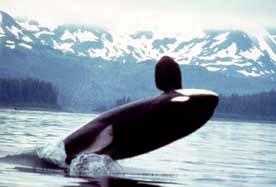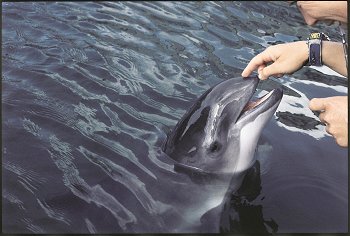AY Honors/Marine Mammals/Answer Key
1. Be able to identify three of each of the following and know where each is found. Know at least one by scientific name from each group:
a. Toothed Whales
Physeter macrocephalus
Sperm whale (Physeter macrocephalus)
Where found: Sperm whales are found in all the oceans of the world.
Description: The Sperm Whale is the largest of all toothed whales and is the largest toothed animal alive, measuring up to 18 metres (60 ft) long, as well as being the largest known predator ever to exist, apart from the blue whale. The Sperm Whale's enormous head and distinctive shape, as well as its central role in Herman Melville's Moby-Dick, have led many to describe it as the archetypal whale.
Pygmy sperm whale (Kogia breviceps)
Where found: Pymgy Sperm Whales are found in the temperature waters of the Atlantic, Pacific and Indian Oceans. However, they are rarely sighted at sea, so most data comes from stranded animals - making a precise range and migration map difficult. They are believed to prefer off-shore waters.
Description: The Pygmy Sperm Whale is one of three species of whale in the sperm whale family. They are not often sighted at sea, and most of our understanding of the creatures comes from the study of washed-up specimens.
Narwhal (Monodon monoceros)
Where found: The narwhal is an Arctic species of cetacean. It is a creature rarely found south of latitude 70°N.
Description: The most conspicuous characteristic of male narwhals is their single extraordinarily long tusk that projects from the left side of the upper jaw and forms a left-handed helix. The tusk can be up to 3 m (nearly 10 ft) long (compared with a body length of 4–5 m [13–16 ft]) and weigh up to 10 kg (22 lb).About one in 500 males has two tusks, which occurs when the right tooth, normally small, also grows out. Although rare, a female narwhal may also produce a tusk.
Beluga whale (Delphinapterus leucas)
Where found: The Beluga Whale or White Whale is an Arctic and sub-arctic species of whale.
Description: Th Beluga Whale is commonly referred to simply as the Beluga - the word derives from the Russian word for white. The head is also unlike that of any other cetacean - its melon is extremely bulbous and even malleable. The beluga is able to change the shape of its melon by blowing air around its sinuses.
Dolphins and porpoises are also classified as toothed whales, but since they appear as a separate group in this requirement, they are not listed here.
b. Baleen Whales
c. True Seals
d. Eared Seals
e. Dolphins/Porpoises
Orca, or killer whale (Orcinus orca)
Where found: The orca is found in all the world's oceans, from the frigid Arctic and Antarctic regions to warm, tropical seas.
Description: The Orca or Killer Whale is the largest species of the oceanic dolphin family (Delphinidae). Orcas are versatile predators, with some populations feeding mostly on fish and others on other marine mammals, including large whales. Wild orcas are usually not considered a threat to humans.
Tursiops truncatus
Bottlenose dolphin (Tursiops truncatus)
Where found: The bottlenose dolphin inhabits warm and temperate seas worldwide and may be found in all but the Arctic and the Antarctic Oceans.
Description: The Bottlenose Dolphin is the most common and well-known dolphin species. They are gray, varying from dark gray at the top near the dorsal fin to very light gray and almost white at the underside. This makes them harder to see both from above and below when swimming. The elongated upper and lower jaws form what is called the rostrum and give the animals their name of bottlenose. The real nose however is the blowhole on top of the head, and the nasal septum is visible when the blowhole is open. Their face shows a characteristic "smile".
Common dolphin (Delphinus delphis)
Where found: The common dolphin is widely distributed in temperate, sub-tropical and tropical waters throughout the world in a band roughly spanning 40 degrees south to 50 degrees north. The species typically prefer enclosed bodies of water such as the Red and Mediterranean Seas. Deep off-shore waters and to a lesser extent over continental shelves are preferred to shallow waters. Some populations may be present all year round, others appear to move in a migratory pattern. Preferred surface water temperature is 10-28 degrees Celsius.
Description: Common dolphins travel in groups of around 10-50 in number and frequently gather into schools numbering 100 to 2000 individuals. These schools are generally very active - groups often surface, jump and splash together. Typical behavior includes breaching, tail-slapping, chin-slapping, bow-riding and porpoising.
Neophocaena phocaenoides
Finless Porpoise (Neophocaena phocaenoides)
Where found: The Finless Porpoise lives in the coastal waters of Asia, especially around India, China, Indonesia and Japan. A unique fresh water population is found in the Yangtze River. At the western end, their range includes the length of the western coast of India and continues up into the Persian Gulf. Throughout their range, the porpoises stay in shallow waters (up to 50m), close to the shore, in waters with soft or sandy seabeds. In exceptional cases they have been encountered as far as 100 miles off-shore in the East China and Yellow Seas, albeit still in shallow water.
Description: The Finless Porpoise almost completely lacks a dorsal fin. Instead there is a low ridge covered in thick denticulated skin. Adult Finless porpoises are a uniform light grey colour. Infants are mostly black with grey around the dorsal ridge area, becoming grey after 4-6 months.
Harbour Porpoise (Phocoena phocaena)
Where found: The Harbour Porpoise, as its name implies, stays close to coastal areas or river estuaries and as such is the most familiar porpoise to whale watchers. This porpoise often ventures up rivers and has been seen hundreds of miles from the sea.
Description: The Harbour Porpoise is a little smaller than the other porpoises. It is about 75 cm long at birth. Males grow up to 1.6 m and females to 1.7 m. The females are correspondingly heavier, with a maximum weight of around 76 kg compared with the males' 61 kg. The body is robust and the animal is at its maximum girth just in front of its triangular dorsal fin. The beak is poorly demarcated. The flippers, dorsal fin, tail fin and back are a dark grey. The sides are a slightly speckled lighter grey. The underside is much whiter, though there are usually grey stripes running along the throat from the underside of the mouth to the flippers.
f. Walruses (one kind)
g. Sea Otter (one kind)
h. Manatees
2. Know and locate the story of how God used a whale in Bible times.
3. What is the largest mammal in the sea?
Largest is the blue whale (Balaenoptera musculus)
4. Explain the following words:
a. Breaching
Breaching is when a whale leaps into the air and falls on their backs. There are a variety of explanations about why different whales and dolphins perform this artful leap. Some researchers have proposed it may be a behavior to dislodge parasites off of the whale's back, while others have interpreted it as a form of communication. Some believe the whale is just having fun!
b. Echolocation
c. Spyhopping
Spyhopping is when a dolphin and whales are in a vertical stance so they can look at their surroundings above the water. The whale slowly rises straight out of the water, until its eye is above the water surface. After a few moments, the whale sinks back down. Again, we cannot be sure why whales spyhop, but they may be coming up to take a look around.






